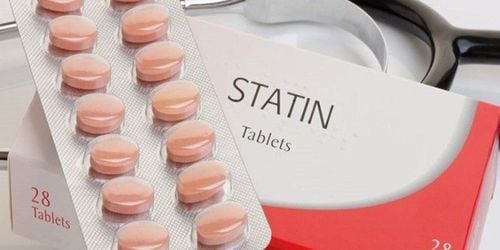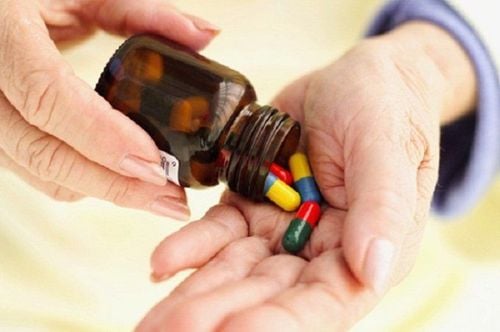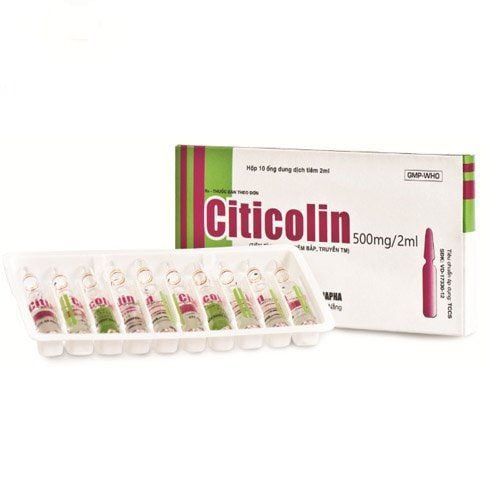This is an automatically translated article.
Noklot 75 mg medicine has the main ingredient is Clopidogrel bisulphate and other excipients in a sufficient amount. This is a drug used to prevent atherosclerotic events (myocardial infarction, stroke, cerebrovascular accident) in people with atherosclerotic disease who have recently had a stroke or a recent infarction. cardiomyopathy or peripheral arterial disease has been identified.
1. What is Noklot 75mg?
Noklot 75mg drug is prepared in the form of film-coated tablets, each film-coated tablet contains the active ingredient Clopidogrel bisulphate equivalent to clopidogrel 75mg. The drug is packaged in a box of 3 blisters, each blister contains 10 film-coated tablets.
Each Noklot 75 mg tablet contains the following ingredients:
Clopidogrel 75mg (as Clopidogrel bisulphate). Other excipients with a sufficient amount of 1 tablet. Active ingredient Clopidogrel when entering the body is converted into substances that inhibit platelet aggregation. The mechanism of action is that the active metabolite selectively inhibits the binding of ADP (adenozin diphosphate) to its platelet receptor, followed by ADP-mediated activation, leading to inhibition of ADP. platelet aggregation.
The drug is used to prevent the risk of stroke or myocardial infarction caused by atherosclerosis.
2. Effects of Noklot 75 mg
2.1. Indications of Noklot 75 mg drug Noklot 75 mg is indicated for use in the following cases: Prevention of complications caused by atherosclerosis (stroke, myocardial infarction, cerebrovascular accident) in patients with atherosclerotic disease, recent stroke, recent myocardial infarction, or pre-defined peripheral arterial disease.
2.2. Pharmacodynamics of Noklot 75 mg Active ingredient Clopidogrel is one of the new clopidogrel metabolites that inhibit platelet aggregation. Clopidogrel is metabolised by CYP450 enzymes to active metabolites that inhibit platelet aggregation. Clopidogrel's active metabolite selectively inhibits the binding of adenosine diphosphate (ADP) to its platelet receptor and subsequently ADP-mediated activation of the GPIIb/IIIa glycoprotein complex, thereby exerting an inhibitory effect. inhibit platelet aggregation.
Inhibition of platelet aggregation is dose dependent. When used with repeated doses of 75 mg Clopidogrel or Noklot 75 mg daily, there was an inhibitory effect on ADP-induced platelet aggregation from day one. Inhibition reached steady state between day 3 and day 7.
At steady state, the mean inhibition with Noklot 75mg daily dose was between 40% and 60%. Platelet aggregation and bleeding time will return to the limit of normal after discontinuation of treatment, usually within 5 days.
2.3. Pharmacokinetics of Noklot 75mg Absorption: Active ingredient Clopidogrel is rapidly absorbed after repeated oral dosing of Noklot 75mg/day (basic therapeutic dose). With peak plasma concentrations (about 3 mg/l) of the major metabolite occurring approximately 1 hour after dosing. Distribution: In vitro, the active substance Clopidogrel and its major metabolites are reversibly bound to human serum proteins (98% to clopidogrel and 94% to the metabolite). In vitro, this binding is not saturated over a wide concentration range. Metabolism: Clopidogrel is extensively metabolised in the liver. The major metabolite is a carboxylic acid derivative, both the parent compound and the carboxylic acid derivative having no antiplatelet activity. Elimination: The half-life of the major metabolite is 8 hours after single and repeated dosing. Administration of Clopidogrel with food did not significantly alter the bioavailability of Clopidogrel as assessed by the pharmacokinetics of the major metabolite. Absorption: Clopidogrel is rapidly absorbed after oral administration. Absorption is at least 50% and is not affected by food. Plasma drug concentrations were not determined 2 hours after oral administration. Excretion: Clopidogrel and its metabolites are excreted in the urine and feces. The mean half-life of the carboxylic acid derivative is about 8 hours.
3. Usage and dosage Noklot 75 mg
3.1. How to use Noklot 75 mg Noklot 75 mg orally, can be taken with or without meals. The reason is that the drug is not affected by food.
3.2. Dosage of Noklot 75 mg People with a history of atherosclerosis: The recommended dose of Noklot 75 mg is 75mg, taken once a day. The prophylactic dose to prevent thromboembolic disorders such as myocardial infarction, peripheral artery disease and stroke is: 1 tablet Noklot 75 mg, 1 tablet per day. Acute coronary syndrome (associated with unstable angina/non-Q-wave myocardial infarction): Initial dose is 300 mg once daily. The maintenance dose is 1 Noklot 75 mg tablet per day. No dose adjustment is required for the elderly or those with kidney disease. However, the above dosage is for reference only. The specific treatment dose depends on the condition and the progress of the disease of each person. For the right therapeutic dose, you need to consult your treating doctor or medical professional.
3.3. If you miss a dose of Noklot 75 mg, use it as soon as possible. However, if it is almost time for the missed dose, skip the missed dose and take your next dose at the scheduled time. Note that you absolutely should not use Noklot 75 mg with double the prescribed dose.
4. Undesirable effects of the drug Noklot 75 mg
Clopidogrel is generally well tolerated. However, you also have some unwanted effects when using Noklot 75 mg.
Common Adverse Reactions: Gastrointestinal disturbances including diarrhea, abdominal pain, dyspepsia, abdominal distention, vomiting and nausea and skin allergies such as red rash and pruritus. Common adverse effects: Chest tightness, nosebleeds. Rare adverse effects: Gastrointestinal bleeding, gastric ulcer, severe neutropenia or agranulocytosis, thrombocytopenia, hemorrhagic skin rash due to thrombocytopenia, aplastic anemia, kidney disease such as nephritic syndrome, loss of taste, acute arthritis. In addition, other side effects may be encountered such as thrombocytopenia, intracranial hemorrhage, eye bleeding.
5. Drug interactions Noklot 75 mg
Aspirin: A pharmacodynamic interaction between Clopidogrel and Aspirin may occur, leading to an increased risk of bleeding. Therefore, you need to be careful when combining these two drugs. However, the active ingredients Clopidogrel and Aspirin can be combined for up to 1 year. Heparin: A pharmacodynamic interaction between Clopidogrel and Heparin may lead to an increased risk of bleeding. Therefore, the concomitant use of these two drugs should be carefully considered. Warfarin: Causes an increased risk of bleeding, so when using Clopidogrel and Warfarin, caution should be taken. Non-Steroidal Anti-Inflammatory Drugs (NSAIDs): Concomitant use of naproxen and clopidogrel may increase the risk of potential gastrointestinal bleeding. Therefore, you need to be careful when using the combination of Clopidogrel with non-steroidal anti-inflammatory drugs. Drugs Metabolized by the Cytochrome P450 System: At high concentrations in vitro, clopidogrel inhibits Cytochrome P450 (2C9). Therefore, it may affect the metabolism of phenytoin, tamoxifen, tolbutamide, warfarin, furosemide, fluvastatin and many other non-steroidal anti-inflammatory agents. However, there are no clinical data on the severity of these interactions. You need to be careful when combining clopidogrel with the above drugs. Other Combination Treatments: Concomitant use of Noklot 75 mg with an inhibitor of CYP2C19 enzyme activity may reduce concentrations of the active metabolite Clopidogrel. Therefore, caution should be exercised when co-administering CYP2C19 inhibitors such as omeprazole and esomeprazole, carbamazepine, oxcarbazepine and chloramphenicol. To ensure safety, avoid adverse interactions with your body, you need to inform your treating doctor about all the medicines you are taking.
6. Some notes when using Noklot 75 mg
Before using Noklot 75mg you need to carefully read the instructions for use and refer to the information below.
6.1. Contraindicated when using Noklot 75 mg Noklot 75mg drug is contraindicated in the following cases:
Hypersensitivity or local sensitivity to Clopidogrel or any of its ingredients. People with diseases related to pathological bleeding such as peptic ulcer or intracranial bleeding. People with severe liver failure. 6.2. Caution should be exercised when using Noklot 75 mg Active ingredient Clopidogrel is metabolized by the enzyme CYP2C19 to an active metabolite. Co-administration of Clopidogrel with drugs that inhibit the activity of the CYP2C19 enzyme reduces the concentration of the active metabolite of Clopidogrel, resulting in decreased antiplatelet activity. The safety and effectiveness of Noklot 75 mg in children have not been established. Use Noklot 75 mg for pregnant and lactating women only when absolutely necessary. Ability to drive and use machines: Clopidogrel does not affect the ability to drive and use machines. Pregnancy: There are no adequate and well-controlled studies of Noklot 75 mg in pregnant women. Therefore, do not use Noklot 75 mg for pregnant women unless necessary and prescribed by a doctor. Lactation: There are no studies to prove that clopidogrel is excreted in breast milk, so caution should be exercised when clopidogrel is used in nursing women. Noklot 75 is used to prevent atherosclerotic events (myocardial infarction, stroke, cerebrovascular accident) in people with atherosclerotic disease who have recently had a stroke or a recent infarction. cardiomyopathy or peripheral arterial disease has been identified. To ensure effectiveness and avoid side effects, patients need to take the drug as prescribed or as directed by a doctor or pharmacist.
Follow Vinmec International General Hospital website to get more health, nutrition and beauty information to protect the health of yourself and your loved ones in your family.
Please dial HOTLINE for more information or register for an appointment HERE. Download MyVinmec app to make appointments faster and to manage your bookings easily.













